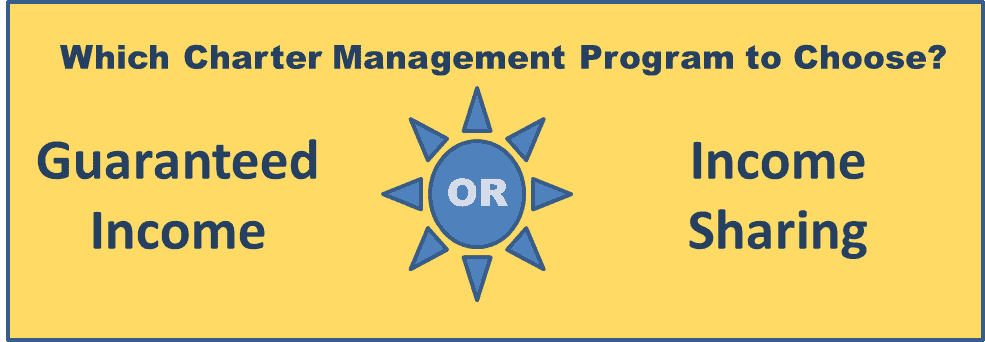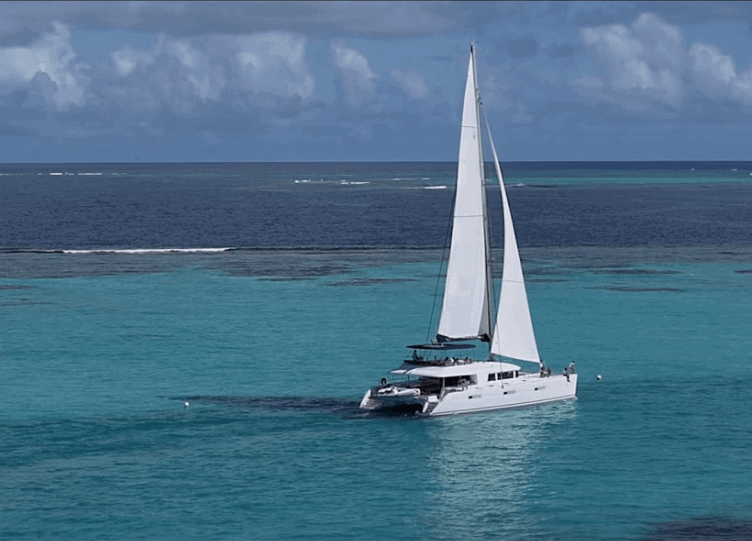The Catamaran Guru is a brand-independent yacht brokerage working with various charter management companies and yacht brands to bring our boat-buying clients the programs and boat models that are best for their situation and goals. Catamaran Guru is no longer affiliated with Dream Yacht (DYC).

Placing a yacht into charter management is a good way to reduce the cost of the boat and also offset the cost of ownership. There are different types of management programs offered by the charter industry.
We will analyze and explain here the different options to ensure a good understanding for owners of what charter management really entails.
The two most popular programs offered by most charter companies are the “Guaranteed Income Program” and the “Performance or Income Sharing Program” that, in all probability, are the two options that you will be presented with.
Guaranteed Income Charter Program
The Guaranteed Program is the option offered by most of the large, well-established companies and is very popular for owners who want to have a “no hassle” ownership experience.
Yacht Finance
The owner must qualify for financing which can be challenging because most lenders are very sticky on making loans for yachts going into charter. There are, however, a few known lenders who have certified these programs, and will approve transactions with well-qualified buyers like Essex Credit / Shore Premier Finance
Deposit
Once the financing approval has been received, the buyer will then typically pay a 20% deposit, while the balance of 80% is due upon completion of the yacht at the factory. The deposit can vary and be as low as 10% or as high as the buyer wishes, which will obviously facilitate the financing of the purchase price initially. At closing the ratio is usually 20% from the buyer and 80% from the finance company. *See important note about financing issues at the end of this article.
Yacht Price & Equipment
Yacht Expenses
The program is structured so that after that deposit, the charter company pays for ALL the expenses except the mortgage but including, insurance, dockage, maintenance and general operating expenses. The owner pays literally ZERO for the entire duration of the program.
Guaranteed Income
The guaranteed payment, which is made monthly, typically amounts to more or less 9% annually of the yacht’s initial purchase price. It is enough to cover a typical mortgage payment making the entire proposition cash neutral for the duration of the program.
Yacht Charter Term / Duration
The term varies from 54 to 66 months; in general, the longer the term, the more guaranteed income you will receive. This is an important consideration when shopping companies or comparing programs.
Yacht Owner Exchange
While the boat is in service, the owner will have exchange privileges enabling sail on a similar boat at any of the company’s charter bases worldwide. While there is no charge for the actual charter, be aware that there are fees such as cleaning or “turnaround” costs, diesel, ice, etc. Familiarize yourself with the exact fee structure for the various yacht charter companies.
Yacht Maintenance
The charter company is totally responsible for the maintenance and upkeep of the yacht for the duration of the program. However, this does not mean that the yacht owner can completely leave it all up to the charter company. It is strongly recommended to thoroughly check on your boat every time you are on board for owner use. Make a list of all items needing attention from the technical staff and give it to the maintenance manager then follow up to ensure all items are completed.
Yacht Phase-Out
When the contract expires, the boat is “phased out” and the owner must take possession of the boat. Most charter companies will have a phase out program written into the management agreement that stipulates that the boat must be handed back in good working order except for fair wear and tear. It is critical for the buyer to fully understand the obligations of the charter company with regard to the phase out: this component will determine the condition and resale value of the boat after the owner takes possession. The phase out should be managed by the owner to ensure that the boat is in the best possible condition and involves a pre-phase out survey by an independent surveyor appointed by the owner and final acceptance after phase out.
Four Options At The End Of The Program
- Private use
- Second-tier charter operation for another 5 years
- Sell the boat
- In some cases the charter company will trade the boat in, or alternatively assist the buyer to sell the boat and upgrade to a new boat to be placed back into the program.
Guaranteed Income Charter Program PROS
- No maintenance or accounting involvement – hassle-free ownership
- Full financial visibility until the end of program – absolutely no surprises.
- Cash neutral program – yacht charter company pays all operating costs and the guaranteed payment covers the mortgage.
- Worldwide owner exchange on similar yacht
- No risk to the owner if the boat does not charter for whatever reason – guaranteed payment, no downside.
- Yacht undergoes extensive phase-out maintenance work at the end of program, at the charter company’s expense.
Guaranteed Income Charter Program CONS
- No control over maintenance for the duration of the program – maintenance is done at the discretion of the charter company.
- Fixed return – no upside if the boat charters a lot and generates a large profit.
- No tax advantages available – income is deemed passive under this program, see Section 179 Explained for Yacht Ownership.
The Advantage For The Charter Company With The Guaranteed Program
- No monthly accounting, which is a huge time sink.
- Maintenance is done at the company’s discretion. This negates owner involvement which can be time consuming and often problematic for the company.
- The phase out at the end of the program allows the charter company to address all outstanding issues at one time with an independent survey as guidance.
- The boats are all interchangeable in terms of usage or booking, and so if there is a problem on one boat, the charterer’s party can be switched at the discretion of the charter company without having to account to the owner and since the owner gets paid no matter what, this is of no concern for the owner.
Performance or Income Sharing Charter Program

The Performance Program is designed to be an income sharing relationship. The owner is credited for the full net charter income after booking commissions and the charter company bills the owner for services. While this program definitely yields the owner more income, it requires a lot more personal involvement. Smaller companies tend to offer this program as opposed to the guaranteed program because it represents less risk or liability to them. As with the guaranteed program, the purchase requirements and qualifications with respect to financing, down payment, yacht specification, equipment and delivery to the base are the same as stated previously.
Charter Income Split
With the Performance Program, there is typically a split of the net charter income.
- That split usually ranges from 65% Owner – 35% Charter Company, to 80% to the owner and 20% to the Charter Company.
- The reality, often misunderstood by the boat buyer, is that the split is almost completely irrelevant and used as a marketing tool when it looks very favorable to the owner.
- Truth is, only the bottom line is relevant. It is what the owner is charged for after the split (costs of the price of services, booking commission paid to charter brokers, etc.) that truly determines the bottom line and not the split formula.
Charter Booking Revenues
Some companies rely entirely on outside booking agents, in which case the commission component is high, while others have a booking office in-house with only occasional use of outside booking agents.
- The issue here is that the outside booking agents charge 15% to 20% commission, which means that the owner starts with 15-20% less income per charter.
- Conversely, the charter company’s in-house booking office might charge less or no commission at all.
- Therefore, as an example, if there is an outside booking agent 100% of the time and the split is 80/20, then the owner will earn $64 on every $100 received.
- If there is no outside booking agent, and if the charter company does not charge a booking commission, with a split of 65/35 the owner will earn $65 on every $100. In that example, an 80/20 split that seemed very attractive at first becomes less favorable than a 65/35 split.
- This is why it is very important to know and understand how the booking commissions work because they have a big impact on the final outcome.
Yacht Expenses & Billing
Because this is an “income-sharing program”, the owner needs to know what the costs are, and how they will be billed to him.
- For example: hourly labor rate (is it $50 per hour, 75 per hour or higher), dockage and electricity costs, turn around costs, insurance or any other fixed or variable expenses the owner will be responsible to pay for.
- It is very important to analyze these costs to see what the actual bottom line income is projected to be.
- As you have seen, the split does not determine the bottom line and will be affected by many factors. Do not be blinded by this.
Yacht Maintenance
Generally speaking, the maintenance of a boat in a performance program should be better because the charter company bills for services and the owner is involved in the management and operation of the yacht.
Income
Depending on the type of boat, configuration and location, the performance program will yield about 30% higher income than the guaranteed program to the owner, which is a substantial difference.
Typically, there is no phase-out for yachts in this program. The reason for this is because if the maintenance is being done regularly and diligently, the yacht should be in good condition at all times, including the end of program. If there were any issues that needed to be addressed, the owner would be responsible for the expense, which means that the phase out provision is not applicable.
Four Options At The End Of The Performance Program
- Private use
- Yacht placement in a second tier charter operation for another 2 to 5 years
- Sell the boat.
- In some cases the charter company will trade the boat in or alternatively assist the buyer to sell the boat and upgrade to a new boat back into the program.
Yacht Performance Program PROS
- Better ongoing maintenance – owner is involved on a month to month basis and is billed for services; maintenance is not discretionary.
- Much higher financial return with upside potential.
- Owner is able to place the yacht into a Corporation (LLC pass-throught entity) for substantial tax advantages.
- Boat should generally be in better condition at end of program.
Yacht Performance Program CONS
- No protection from downside: if charter bookings drop off, or economic conditions or airline fares become unfavorable, the owner is still responsible for all the upkeep and costs
- No owner exchange / reciprocal privileges as in the guaranteed programs: Owner can only use own boat at her location
- Owner has to be actively engaged in the operation of the vessel – it is not “hands off” ownership.
Advantages To The Charter Company For The Performance Program
- No contingent liability that comes with a Guaranteed Program; the financial risk is with the owner.
- The maintenance is entirely invoiced to the owner and there is no phase out obligation.
- The Charter Company generally earns less income from this program, with the owner benefiting more than in the guarantee program, but the trade off is that the risk is shared.
- The owner is actively involved and the administration requirements on the charter company’s side are high compared to the guaranteed program.
Yacht Charter Management Options
The main aspects to consider for the boat buyer when choosing charter management programs are
- His/her risk tolerance (financial visibility vs. potential upside, similar to the difference between a bond and a stock)
- Need for tax benefits
- Attraction to exchange programs between locations vs. sailing in one cruising ground
- Interest in involvement in the yacht management vs. hands-off experience.
Here are some resources to help you find more information to decide which yacht ownership program is right for you:
- Charter Management Programs In A Nutshell
- Yacht Charter Management Program Pros & Cons
- Yacht Charter Management Programs Explained
Financial Considerations For Successful Yacht Charter Management
There is a very important element to be considered which is not often highlighted when you are speaking with the salesperson that presents the programs and options: Exit Strategy
- Example: any loan with 80% financing (the usual configuration) paired with a maturity higher than 12 years normally results in the buyer being significantly upside down at the end of the charter program. The reason for this is that the typical charter boat depreciation and value on the second-hand market ends up being less than the loan payoff amount.
- With a longer term (15 to 20 years) the interest component is higher which impacts the principle reduction, this means that at the end of 5 years the principle has not been reduced to a level where the boat can be sold without the owner having to pay in.
- The reason that you should pay attention is because a 5-year financial proforma on any boat, paired with a 15 or 20 year-mortgage looks significantly better than one with a 10-year mortgage with regard to the monthly and annual cash flow.
- The resale value of a charter yacht is determined by the market as well as supply and demand so you need to be aware of what you will face when you want to sell.
- Depending on the company that is chosen some insist that the boat is built to a very exact specification, which would identify it as a charter boat, to the other end of the spectrum where the owner can spec the boat to their personal taste.
- As an example quoting the two extremes – A 45 foot, four-cabin purpose-built charter catamaran would have a significantly lower resale value than a 45 ft, three cabin (owners version) catamaran that was spec’d out personally. Firstly the one would be branded a charter boat and there would probably be up to 15 identical boats competing on the market at the same time versus a one-off owner’s version that is not readily identifiable as a charter yacht. In the one case the price would be driven down by supply and demand as well as the charter spec versus the alternative as stated above.
There are some variations on these programs but generally, most charter companies are set up for the two basic programs.
For more information about Charter Management, contact us.





